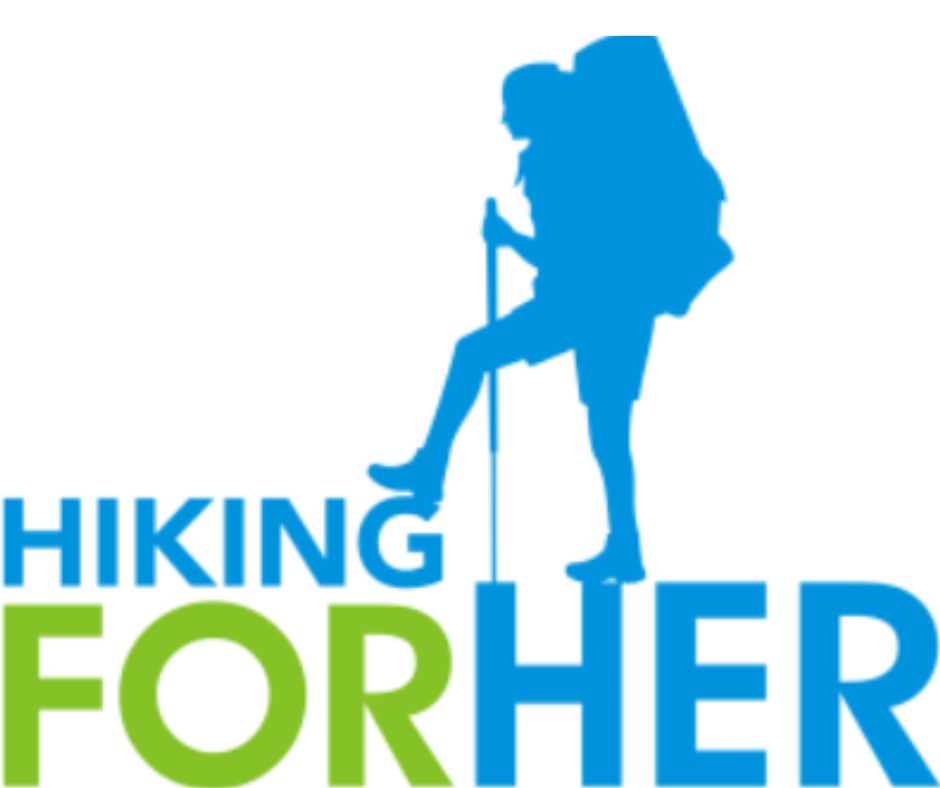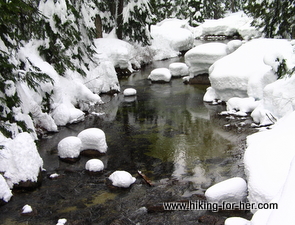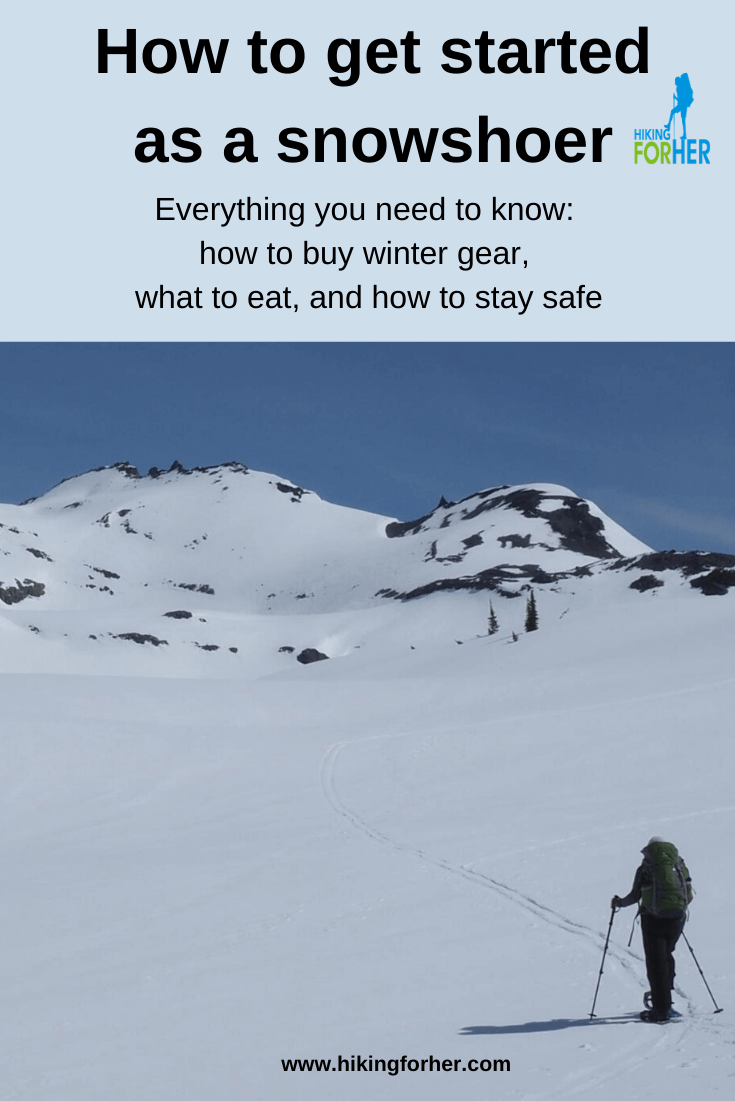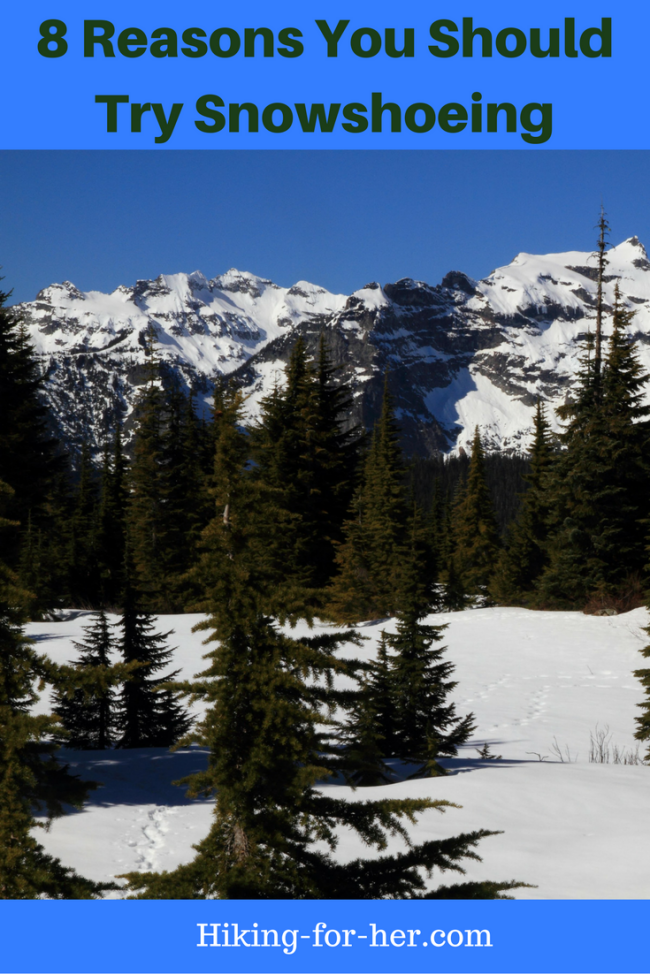Snowshoeing:
Best Gear And Resources For Snowshoe Hikes
By Diane Spicer
Snowshoeing = hiking + bigger boots.
Woohoo!! What a great equation!
Seems obvious to me now, but it took me awhile to put that outdoor equation together.
I used to feel trapped inside the overheated, dry as a desert house during the long snowy winters in upper Michigan, when temperatures dipped below zero for days on end and the snowstorms just kept coming.
And then one fine day, I borrowed a pair of old fashioned, hand made bear paw snowshoes.
My world has never been the same since.
And I mean that quite literally.
So let me share with you why you (and your loved ones) should try snowshoeing, along with some of the best tips on how to get started as a newbie snowshoer.
Best snowshoeing tips first!
To shortcut things, drop down to Snowshoeing FAQ.
Or use these buttons:
Or grab a cup of tea and keep reading to pick up all the best tips for making winter hiking on snowshoes not only enjoyable, but safe and comfortable. Plan a winter adventure right here!
More effort, planning and gear is required
compared with three season hikes
Snowshoeing a hiking trail you're familiar with under mild conditions is going to be a completely new experience with "boats" on your feet. (I prefer to call them floats!)
That includes some of the gear you'll carry into the pristine winter wonderland.
This unique, low tech sport requires very little in the way of gear, but you will need to put some thought and experimentation into choosing rock solid snowshoeing gear.
Why?
In wintertime, you have less margin for error: shorter daylight hours, more extreme temperatures, and more effort for less pay off. You want to be prepared, in fact a bit over prepared!
Snowshoeing gear checklist
As for the physical effort required, you won't be shocked to hear that it takes more work on the trail, compared with summer hiking, partly due to your more rugged winter gear.
Your winter hiking boots are going to weigh more.
Your survival gear and Ten Essentials are going to set a minimum weight limit for you to carry on your back.
- But you'll want to carry more high calorie food, and warmer clothing for head, neck, hands and torso.
- You'll also want to consider carrying a thermos full of a hot, calorie rich beverage. Hot chocolate time!
If you're not already using trekking poles, add them to your snowshoe gear list. Read why here.
Also carry backcountry navigational tools with you, like a personal locator beacon or satellite communication device, if you venture away from established snow parks or designated snowshoe trails.
- You may think you know the area well, but when everything is blanketed in snow, your usual trail markers are erased.
- Your sense of time will be altered when you head into snow covered areas and you may underestimate the amount of daylight you have left.
- Weather can change rapidly in the winter, making you deal with complications of navigation and light levels.
Hiking For Her's best snowshoeing gear guide will give you lots of recommendations for the best snowshoe gear.
Best boots for snowshoeing
My most cherished possession for winter snowshoeing outings isn't my carefully selected pair of snowshoes, it's my boots!
My waterproof, insulated, clunky, absolutely not stylish, but uber-functional and lightweight winter boots:
 Baffin Icefield Snow Boots
Baffin Icefield Snow Boots
If you prefer more of a traditional boot look, take a peek at waterproof hiking boots like these. But be sure to add full length gaiters over waterproof pants to prevent snow from reaching your feet.
Choose a great pair of snowshoes with these tips
Here's some good news.
Snowshoeing has gained in popularity lately, at least in the United States. That means there are lots of good brands of snowshoes to choose from.
- That link shows you how to buy the best pair for your particular needs, taking you through features you need for various winter terrain.
Read about the brands I recommend here.
Or read my review of my new MSR Revo Ascents.
- They're best for elevation gain and backcountry terrain.
Try to be realistic about your commitment to this winter sport, and don't over or under spend for features that won't benefit you.
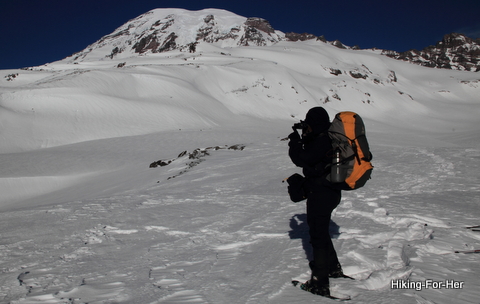 Don't leave much uncovered for the wind to find!
Don't leave much uncovered for the wind to find!
What to wear snowshoeing
Snowshoeing clothing needs to be warm, of course, but also needs to do these things for your hard working body:
- Soak up your perspiration and wick it away from your skin.
- Keep your core temperature protected from the cold.
- Layer easily over and under your other snowshoeing clothes.
Use these tips to select the right clothes for layering.
Here are suggestions for ways to keep your feet and hands warm, too.
Winter conditioning for snowshoeing
You will also be using different muscles, or perhaps I should say you'll use the same old hiking muscles in different ways.
- Be prepared for some soreness!
- Know how to handle inflammation.
And if you're the first person, or the only person (lucky you!!), to go in that direction, you'll need to break trail.
- That's when you work up a good sweat, all for a good cause.
- Take turns with your hiking partners!
- Be sure your quads are conditioned for the heavy lifting: foot + boot + snowshoe + snow.
- And if you're off trail, stop frequently to check your GPS coordinates. Getting lost? No fun in any season, but especially dangerous in the winter. Tip: If you feel at all turned around, simply turn around immediately and follow your own snowshoe trail back to safety.
Modify your hiking nutrition for snowshoeing
Fact: You can't get as far on snow as you can on a dirt trail.
You'll be working hard (burning more calories due to cold temperatures and exertion) for less mileage.
Winter is the time when you should be carrying fats in your hiking lunch.
We've already covered how much harder you'll be working, and carbs alone won't be able to fuel your muscles.
The other reason for adding some fat into your hiking nutrition is to give you extra calories to burn as you keep your core temperature stable in the face of cold windy conditions.
Plus, fat makes you feel satisfied with small amounts, and keeps hunger pangs at bay.
Here is a complete guide to what to eat and drink on a snowshoe hike.
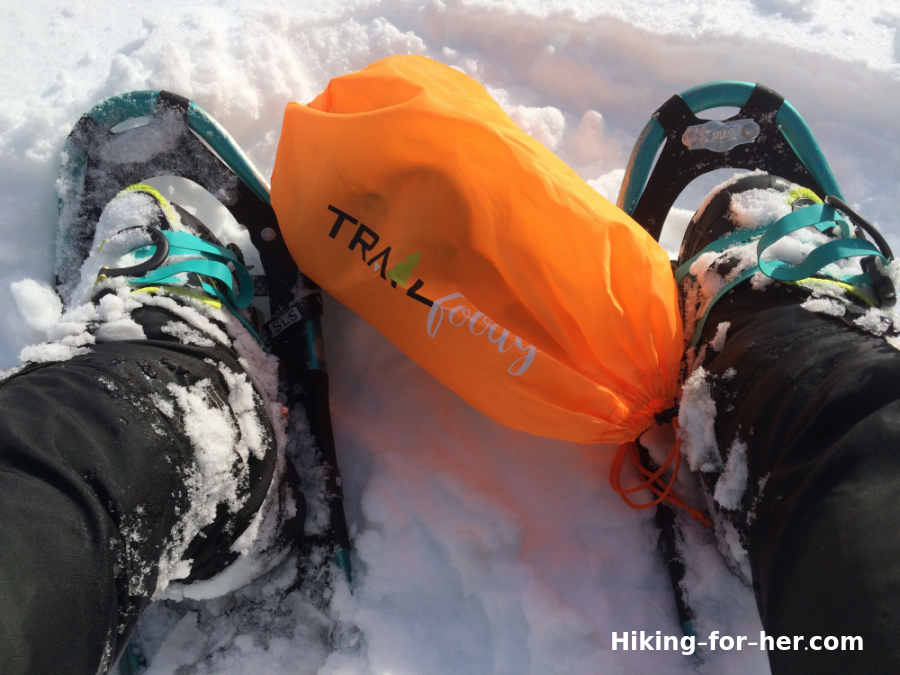 Dig in! Trail snacks keep you fueled on a snowshoe adventure.
Dig in! Trail snacks keep you fueled on a snowshoe adventure.
A few more tools for you
before you go snowshoeing
Strapping on snowshoes to explore a wintry scene is an absolutely amazing experience, regardless of where in the world your snow falls.
- These tips on how to snowshoe will help you make the most of your winter outdoor time.
- Safety tips for snowshoers involve planning, smarts and flexibility along with the ability to quit while you're ahead.
- Also useful: These winter hiking tips, with or without snowshoes.
- You can also download this free pdf "What To Expect": a sheet of tips I hand out to folks who take my snowshoe classes (no longer offered), or are curious about what you need to get started as a snowshoer.
Enjoy these snowshoeing resources!
Now let's turn our attention to the motivation behind this type of winter hiking.
Is snowshoeing fun?
Heck, yeah it's fun!
Let's start this list of reasons to snowshoe with my favorite reason of all:
This winter hiking sport is an amazing opportunity to see places you can't get to during non-winter months.
- Snow covers brush, rock piles, small trees, and other obstacles.
- All you have to do is walk over it all! (after planning a safe route, of course)
All of that walking is a great opportunity to burn tons of calories, allowing you to eat a hearty breakfast, lunch, second lunch, snacks and dinner.
After my most recent snowy adventure at Mt. Rainier, I consumed an entire plate of burritos, rice, and beans, washing it all down with chips and salsa, more chips and salsa.....I thought I'd never feel full again!
This, from a woman who is hard pressed to finish one burrito.
And the best part?
- The bathroom scale never registered this little episode of overindulgence.
So if I sound as if I'm advocating this winter sport as an excuse to enjoy good food, and plenty of it, I am!
If you're considering hiking for weight loss, you can't go wrong with a little physical exertion in cold conditions.
More great reasons to snowshoe
Being outdoors allows you to enjoy the tranquility and serenity of winter.
If you're lucky enough to be able to get away from the noise of human activity, you can marvel at the crunch of snow under your feet that shuts off the instant you stand still.
- Silence! Let it surround you and soothe you.
If you love to observe nature, winter is a marvelous time for you.
- Animals creep out of hiding places and go about their normal activity, because they don't even notice you as you blend into their surroundings.
- And the winter sunlight is so fragile, so welcome, that you see trees and rocks and streams with fresh, appreciative eyes.
Fresh snow also makes animal tracking much easier.
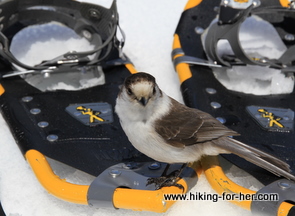 And hungry birds become instant friends when you stop to snack.
And hungry birds become instant friends when you stop to snack.
Snowshoeing for beginners
OK, that's 6 motivations! Here are 2 more reasons to go snowshoeing.
Snowshoeing is one of the few sports that has no learning curve. You're going to go from beginner to competent snowshoer very quickly!
- You know how to walk, so you know how to snowshoe.
The first few minutes might be a bit awkward, but after you hit your stride you'll be whizzing along humming a snowshoeing tune!
Tip: Be sure to choose easy terrain and good weather for your first few snowshoe outings. You want to build your confidence, not get caught up in a death march into the frozen tundra.
The very best reason to try snowshoeing
I've saved the best reason to snowshoe for last:
Snowshoes are not expensive, compared with skiing.
You
can take up this sport by either renting a pair of snowshoes for the
first few times, or buying a pair at your favorite gear store like REI. Not an REI Co-op member? You're missing out on all these REI benefits!
A few more thoughts
regarding this great winter sport
Being able to walk easily over the snow is wonderful because:
- It brings a sense of peace not always achieved during hiking adventures in other seasons.
- And it gives a sense of freedom, too. You can explore, wander, backtrack (literally!), stop, stare, lick tree icicles, or ponder what that rabbit was doing as it laid down its tracks.
But winter hiking also brings responsibility for your safety.
- Be smart about where & how you snowshoe: plan a route you can handle in a short day.
- Eat properly for winter exertion: more fat, less protein and plenty of carbs. More hiking nutrition tips here.
- Stay on marked routes until you're ready with a strong skill set to explore on your own.
- Be prepared mentally and physically for the winter season risks, which may be quite extreme when the weather decides to exert its authority over you as a mere mortal.
Snowshoeing FAQs
Here are some questions that I get asked alot.
Just click on the question for a succinct answer and links to more detailed information about snowshoeing.
What gear do I need for snowshoeing?
What gear do I need for snowshoeing?
What's on your feet is most important. You will need waterproof warm winter boots and moisture wicking socks. Snowshoes must be compatible with your boots, so use these tips for selecting the correct pair.
You will need a pair of trekking poles (also called hiking poles) with winter baskets on the end, for balance and pacing.
Here is a snowshoeing gear guide made to order for a thorough answer to this question.
A clothing layering system is also essential, be sure you choose the right pants, shirt, jacket, hat and gloves.
What are the 10 essentials for snowshoeing?
What are the 10 essentials for snowshoeing?
The 10 essentials for snowshoeing (winter hiking) are the same as for three season hiking. Read about them here.
The difference is in the type of clothing and food you carry with you when you snowshoe. You want high calorie foods and beverages like these for snowshoeing, and adequate winter clothing like this.
Is snowshoeing harder than hiking?
Is snowshoeing harder than hiking?
Yes and no.
Yes, it's harder because your stride on the snowshoes will be wider than in your regular hiking boots or trail shoes.
You will lift your feet higher to accommodate the bulk of your snowshoes and adjust for the amount of snow beneath them.
So your leg muscles will word hard when you are snowshoeing.
No, because you can glide over the tops of the usual trail impediments like downed tree limbs, rocks and roots.
You can access terrain that is off limits to you during summer months, like frozen rivers and lakes.
And because hiking and snowshoeing are at the heart of it just walking, your perception of how hard they are will change every time you get out there.
What burns more calories walking or snowshoeing?
What burns more calories walking or snowshoeing?
The answer will vary depending on the weather, your base weight and your pace.
In cold weather, carrying more survival gear or at least more food and clothing, you will burn more calories compared with a mild summer day hike.
But if you're a three season backpacker who goes fast and light, you could burn just as many calories as a snowshoer who sticks to a groomed, flat trail for an hour or two.
Snowshoeing
|
I get emails all the time about what I wear, eat, carry and love to use on the trail. That's
why I provide affiliate links to you: the best gear that I use myself and have seen used by other hikers is instantly
available for your consideration, and the gear company sends a few
pennies per dollar to this reader-supported hiking website. There is no added cost to you! Everyone ends up a winner: Great gear for you, strong gear companies, and more free hiking tips for everyone. Thanks very much for your support. It's warmly and sincerely appreciated. It also helps send these hiking tips to all your virtual trail buddies around the globe. |
 |
